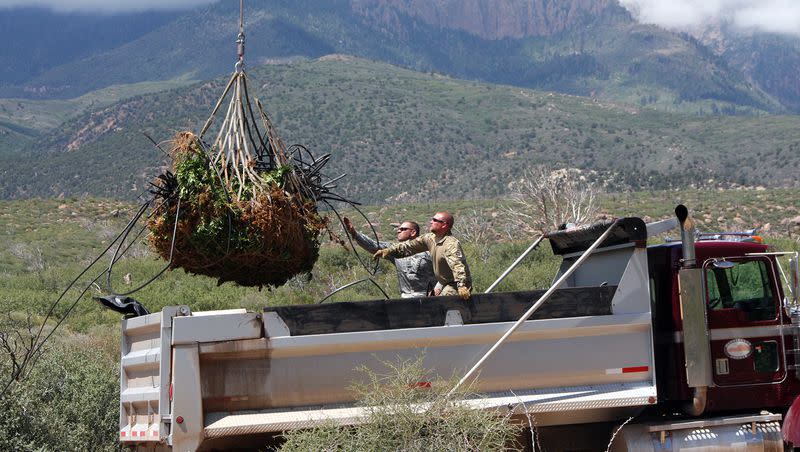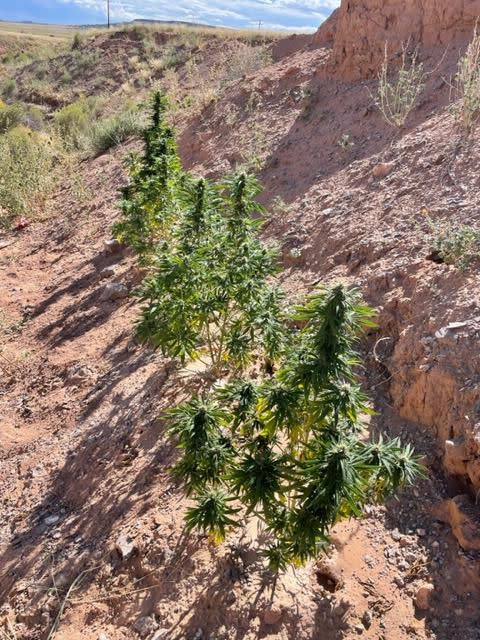Dude! Your illegal stash of weed is a buzzkill for the environment

Earlier this month, the Navajo Police in the Dilkon District of Arizona found 44 marijuana plants illegally growing in a wash, some as tall as two feet.
The police sent out a stern warning: Anyone caught growing, using or transporting cannabis will be prosecuted on the Navajo Nation.
The Navajo Police congratulated the district for stopping that amount of marijuana from hitting the streets of Navajo communities.
Despite the legalization of marijuana in 23 states, three U.S. territories and the District of Columbia, illegal marijuana grows continue to be a problem.
In 2022, the Drug Enforcement Agency’s Domestic Cannabis Suppression program eradicated more than 4.4 million illegally cultivated outdoor cannabis plants and more than 1.2 million illegally cultivated indoor plants. The program also removed 2,840 weapons from cannabis cultivators.

Marijuana and Utah
At one point, Utah led the nation for the number of convictions for marijuana possession on public lands and was responsible for one third of the convictions nationwide. Its wide open public land spaces are not only attractive for outdoor recreation but for remote cultivation of a plant that is still illegal to grow in Utah except under strict supervision by the Utah Department of Agriculture and Food for medical purposes.
Related
Over the years, illegal grows in Utah have spurred multiple arrests and led to the discovery of sophisticated operations like one in Duchesne County where agents seized guns, dynamite, and found a 10-foot long tunnel that led to a bunker hosting 510 plants in a hydroponic grow in 2001.
Related
Law agencies declare war on marijuana growing operations in S. Utah
Marijuana growers the great threat to public safety, top DEA agent in Utah says
Illegal cannabis is a downer for the environment
Aside from being a major product trafficked by the Mexican cartel using mules, or smugglers, and often involving minors, cannabis grown illegally in the United States is an environmental nightmare.
It perhaps is something few freedom loving, peace out fans think about.
Despite being the second most arid state in the nation, Utah was at one time a hot spot for illegal marijuana grows, with many discovered in Washington County and one of the hugest stashes discovered in northern Utah. With water scarcity such an issue in the West, the demand for H20 for the plants is astounding when compared to legal crops.
According to Smartwatering.com a cannabis plant consumes around 6 gallons of water per day during the growing season.
Consider this comparison of water consumption:
Corn requires 1 inch of water per week.
Soybeans require 0.35 inches of water per day.
Alfalfa requires 0.1 inch to 0.3 inches of water per day.
Cannabis requires 1 inch per day.
Aside from the water consumption, illegal growers often use banned pesticides that kill all manner of aquatic species and other wildlife. The California Department of Fish and Wildlife has this to say on illegal cannabis cultivation:
“The direct effects of pesticides on wildlife include acute poisoning, immunotoxicity, endocrine disruption, reproductive failure, altered morphology and growth rates, and changes in behavior.”
It runs the gamut of the food chain. It impacts insects which in turn infects birds which then goes on to impact small mammals, ultimately reducing prey for carnivores such as foxes and lynx. Raptors, in particular, the agency said, are of concern from secondary poisoning. Species include the barn owls, red-shouldered hawks and the bald eagle, our nation’s emblem.
In Utah, there are eight farms that legally cultivate cannabis in grow rooms that occupy 280,000 square feet of indoor space and 5 acres of field. Unlike illegal grow operations, the pesticides used for these plants are strictly controlled under state regulations.
Brandon Forsyth, director of the medical cannabis program for the Utah Department of Agriculture and Food as well as its food laboratory, said scrutiny and testing is key.
“We’ve seen very few problems with pesticide use. We don’t detect it almost ever in products in Utah, and the few times that we have mostly have been attributable to draft from other nearby farms.”
Deputy director Cody James said each product is subject to surveillance to make sure human health is protected, as well as the environment.
“Every product that goes out there is tested for heavy metals that come in fertilizers as well as pesticides, that type of thing,” James said. “There’s testing of every single product to make sure that there is not a concerning amount of anything in there which kind of goes along with the regulatory side of it, as well that they’re not overusing or not giving time for the environment to self clean, if you will.”
Federal drug agents say since the legalization of recreational marijuana in neighboring states, Utah has seen a severe decline in illegal marijuana grows. Hot spots remain, however, particularly in the northwest Pacific region and Humboldt County, Nevada.
“Water was the hardest part in Utah,” one agent said. “Now, you don’t have to fight the weather, the bugs and all the highways and byways.”
The cannabis pollution problem
In addition to the illegal pesticides used in outdoor grows, even cultivating legal cannabis requires nitrogen rich soil. Excess nitrogen is already a huge problem throughout the United States, a dominant culprit in groundwater contamination and runoff which leads to harmful algal blooms making water bodies unsafe for humans and animals.
Related
Effects of algal blooms continue to spread throughout Wasatch Front
Drought intensifies in Utah and the West amid searing heat, no rain
The California wildlife agency notes that illegal grow operators are not concerned about the use of illegal pesticides, deaths of animals or groundwater contamination, soil erosion or more. It is a lucrative business. Even legally, it is a $13.2 billion industry for the United States and is expected to reach a compound growth rate from this year to 2030 of 14.2%, according to Grand View Research.
Cannabis and your lungs
Medical experts warn that inhaling a foreign substance is not a good thing for the respiratory system. Environmental activists condemn emissions from industry, transportation, businesses and homes. It causes premature deaths, increased risk of heart attacks, stroke and early onset of dementia. Air pollution is bad. The Biden administration wants a carbon free economy to tamp harmful pollutants such as fine particulate matter, or PM2.5, and ozone.
Lemon Wheel, Elephant Purple and Rockstar Kush sound pretty innocent, but not when it comes to ground level ozone.
A study published in Atmospheric Scientist found that pot plants are a strong source of potent volatile organic compounds called terpene. When VOCs mix with sunlight, that is when you get the haze and the air quality alerts.
Scientists have launched one of the largest studies on pot farms’ effects on air quality, but because cannabis is an illegal substance due to the federal government, one probe is being carried out in a garage. And Lemon Wheel is being studied, but there are no official studies authorized under federal law.
The Atmospheric Scientist study has suggested the tens of thousands of plants in Denver’s indoor farms — which are mostly found along two busy highways — could, under a worst-case scenario, double the city’s volume of smog-forming VOCs. If the farms “are putting out a significant amount of terpenes, there is not a worse place to put them,” said atmospheric scientist William Vizuete. “If I was designing an ozone reactor, this is what I’d do.”
The Denver study, funded by a state program, will collect more data. It will measure VOC emissions at four farms — two large and two small — over the monthslong cultivation cycle, from planting to processing. The goal is to track emissions across pot varieties, growing conditions, and plant size and age, says project leader Kaitlin Urso of the Colorado Department of Public Health and Environment in Denver.
But because cannabis is “illegal” under federal government drug classifications, the U.S. Environmental Protection Agency is not any help. That is why Vizuete, a researcher at the University of North Carolina in Chapel Hill, grew a dozen pot plants in a garage in Boulder, Colorado.
“To be able to permit (pot farms), we have to at least estimate their emissions,” said Mike Wolf, a regulator in Washoe County in Nevada.
Utah state agricultural officials say the majority of pot farms are in rural areas. That does not mean that state air quality regulators are off the hook for pollution in general, facing lawsuits over ozone that drifts to other states and obscures prized scenic views across the state.
Related
Forsyth said operational plans for legal grow operations in Utah do not include any input by air quality regulators from the Utah Department of Environmental Quality.
Should it?
So far, because the legal cannabis industry in Utah is so fledgling, the ozone issues, water contamination, indoor pollution risks and the atmosphere are shrouded in a cloud of smoke.

